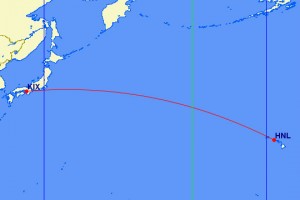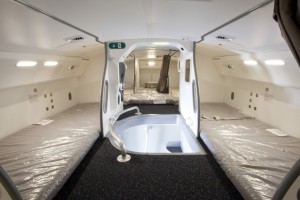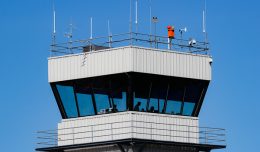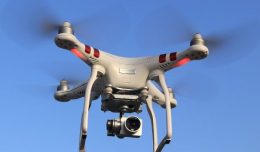(Note: Crew fatigue and crew rest have been a hot topic in the airline industry for the past several years, this year especially with the emergence of Federal Aviation Regulation (FAR) 117. In a 3-part series this week, NYCAviation will explore the issue, its history, pilot experiences, and its solutions, all from the perspective of three different pilots whose duty it is to keep you safe. In Part Three, pilot Karlene Petitt shares with us what it is like to work under the requirements of FAR 117 and the effect of its application on air crews operating international flights. I hope you have enjoyed and learned much from this week’s series. – Phil Derner, Founder)
In January 2014, the United States was slapped in the face with a new regulation to mitigate pilot fatigue: FAR 117. Unfortunately the FAA’s best attempt at solving a serious issue within the commercial aviation industry fell short of accomplishing their desired goal. What the FAA has accomplished with FAR 117 is a world of havoc with passengers and crews alike. Scheduling challenges, cancelled flights, and confusion have all reigned supreme. Sadly, all of these problems come with zero impact on reducing fatigue, especially in the international arena.
The Department of Transportation states:
This final rule addresses fatigue risk in several ways. The underlying philosophy of the rule is that no single element of the rule mitigates the risk of fatigue to an acceptable level; rather, the FAA has adopted a system approach, whereby both the carrier and the pilot accept responsibility for mitigating fatigue. The carrier provides an environment that permits sufficient sleep and recovery periods, and the crewmembers take advantage of that environment. Both parties must meet their respective responsibilities in order to adequately protect the flying public. The final naturally more tired at night than during the day. Under the final rule, flightcrew members will be able to work longer hours during the day than during the night. Significant changes in time zones, a situation unique to aviation, are accounted for to reduce the risk to the flying public posed by “jetlag”.
The new regulation addresses certain issues which impact fatigue, including report time and how long a pilot spends on duty. They are also linked to a pilot’s acclimation to a given theater. FAR 117 defines a theater as the geographic area between the departure and destination points no greater than 60 degrees longitude. According to the regulation, in order to become acclimated a pilot must spend 72-hours in theater or be free from duty for 36 hours.
To those not involved in daily flight operations, these points make sense. Anyone who has traveled internationally during overnight hours has experienced the level of fatigue that ensues. Your body, accustomed to a certain schedule and time zone, has difficulty coping when night arrives early and leaves quickly. For airline crews it can be even more difficult, as they must stay alert and do their work in the limited time they would otherwise have for restful sleep. Unfortunately the creators of this regulation have never worked an international flight, where a rest period during the flight is required. Therefore, they cannot understand what it is like to attempt to sleep in the passenger cabin while a meal service is in progress.
A typical international flight might be from Osaka, Japan (KIX) to Honolulu,Hawaii (HNL). On a flight like

The route from Osaka to Honolulu. The space between the red lines is 60 degrees of longitude. Map courtesy GCMap.com
that, the pilots are out of theater and need a minimum 36-hour layover. The “or” with the 72 hours is the key—if the pilots stayed in Asia after the first flight for a week, their layovers would be reduced due to “in theater” rest requirements.
On this particular day, the flight from Honolulu to Osaka is scheduled to last 10 hours, with a duty period of 12 hours. Because of this, the flight requires three pilots: a captain, a first officer, and a relief pilot. Theses pilots may have flown in from the mainland the day before, crossing multiple time zones. In Osaka, their acclimation period will be the 36-hour layover so this crew can perform yet another crossing. Now they will be flying on during the overnight hours, which is known as flying on the backside of the clock. Their flight will take them through many more time zones and across the International Date Line.
The problem with this acclimation period is the level of fatigue on arrival. The immediate need to sleep after landing overpowers the attempt to adjust to the current time zone. Wake up times and body clock cycles and the ensuing departure time all set up for accumulated fatigue to begin. The real issue is the level of fatigue on arrival—the most critical time of the flight.
The international pilot duty time is regulated by crew rest area availability. For demonstrative purposes, let’s take a typical day in the life of an international pilot and start them in the best of circumstance to see what the regulation calls for in order to fight fatigue on their flight. Joe Pilot’s report time is 1330 (1:30pm), departing at 1500 (3:00pm). He is scheduled for an eleven-hour flight with a crew of three pilots onboard. His duty day is limited to 15 hours. His schedule falls well within the grounds of legal.
He awakens with the family at 0700 (7:00am) and begins his day. Kids to school, a workout, lunch and then it’s time to be at the airport. He feels great. With FAR 117 he is now required to sign his name on the release with the captain to verify he is fit for duty. Today he is the junior pilot onboard, and his fellow crewmembers are not ready to go to sleep just after departure on a sunny afternoon. Unfortunately, neither is Joe. However, seniority rules and he takes the first break.
Per regulation a lie-flat seat in the cabin meets the criteria for a class 2 rest facility*. Immediately after departure, he climbs into his seat and makes his best attempt to use this facility. This is what the regulation requires him to do. His head is 3 feet from the galley, with a just curtain separating him from the chaos, as the flight attendants begin their meal service. Noise, odors, heat, and flight attendant talking prevent Joe from sleeping, despite his best attempt. Then he goes back to work. The next pilot to take their break actually has the best chance of actually getting some sleep. By the time the third pilot’s break rolls around, it will be time for the second meal service. That means that they will likely face the same issues with trying to sleep as Joe did. In all likelihood, two of the three pilots have not been able to get any rest while onboard.
At the end of the flight, Joe pilot has been awake for 19 hours. Of course the end of a flight means landing, which is the time when the pilot’s ability to pay attention is the most critical. After being awake for 17hours, mental capacity has diminished and decision-making and reflex time have been compromised to the point where they are equal to somebody with a .05 blood alcohol content. Without a proper crew rest facility installed on the aircraft, at least one of the three pilots on duty will be fatigued, as they have been awake for an inordinate amount of time. Today this title belongs to Joe Pilot.

Another class 1 crew rest area, onboard a United Airlines 787. This crew rest area is installed above the passenger cabin. (NYCAviation file photo)
We land on the other end of the trip in the morning, but our bodies think it is the evening. Do we sleep? By the time we reach the hotel we have been awake 20 hours. If we don’t sleep, we spend the day wandering around, a group of over tired zombies. If we do sleep, we will wake up in the evening. Wide awake, there will be no hope of us getting any more sleep before our flight back the following morning. Thus the cycle of accumulated fatigue begins.
The only way for an international crew to find meaningful rest on a long haul flight is with a class 1 rest facility*. To think that an international pilot can be rested for a given segment with anything less, unless the flight initiates in the morning of their acclimation city, is pure insanity. With the proper rest facility, efficient napping on a plane is possible. But that place must be carefully designed to be particularly conducive to being able to quickly fall asleep. It must be dark, silent, and cool. There, the pilots can change into comfortable clothing and climb into a sleep sack. Yet this is not the reality of FAR 117. With the new regulations international pilots are also allowed to fly up to nine hours with just two crewmembers, allowing for no rest period at all. Previously, they were limited to eight hours in the air with no break. While the new regulation states the responsibility of being fit for duty falls on the pilot and the company, the FAA must assume a level of responsibility for allowing anything other than a class 1 crew rest facility onboard international flights.
The reality of fatigue continues to exist for two reasons: a lack of proper crew rest facilities on long-haul flights, and the reality of flying international routes across time zones. Crew fatigue is a serious challenge. Unfortunately, the writers of this regulation not only missed the runway with their solution, they landed at the wrong airport entirely.

 Karlene Petitt is a pilot with a major international airline. She currently flies the Airbus A330, and also holds type ratings in the Boeing 727, 737, 747-200 and -400, 757 and 767. She holds two masters degrees, an MBA and an MHS. She is an accomplished novelist. Her first book, Flight for Control, was published in 2012. Her second novel, Flight for Safety, was just released.
Karlene Petitt is a pilot with a major international airline. She currently flies the Airbus A330, and also holds type ratings in the Boeing 727, 737, 747-200 and -400, 757 and 767. She holds two masters degrees, an MBA and an MHS. She is an accomplished novelist. Her first book, Flight for Control, was published in 2012. Her second novel, Flight for Safety, was just released.
* Crew Rest Area Classifications
Class 1 Rest Facility. The crewmember rest facility should be in a location where intrusive noise, odors, and vibration have minimum effect on sleep. The spectrum of the sound within this facility should be limited to broadband without annoying tones. Special attention should be given to the existence of doors, passenger convenience systems, public address systems, etc., in the immediate area to minimize intrusive noise and ensure they have minimal effect on sleep. A noise level during cruise flight in the range of 70 to 75 dB A is considered a reasonable design objective (SAE ARP 4101/3, 1323, 4245).
(2) Class 2 Rest Facility. A class 2 rest facility is a seat in an aircraft cabin that allows for a flat or near flat sleeping position, and it is separated from passengers by a minimum of a curtain to provide darkness and some sound mitigation. It is reasonably free from disturbance by passengers or flightcrew members. Examples are so-called “Lie-Flat” seats, or “Flat Bed” seats (§ 117.3, TNO c.
A common grouping of seats (row subsection) that should be shared only by other crewmembers. The seat should be separated from the cockpit and passengers by acoustic curtains or panels and provisions for darkening and sound mitigation of the sleep environment should be available (TNO REPORT recommendation paragraph 5.2.5).
(3) Class 3 Rest Facility. A class 3 rest facility is a seat in an aircraft cabin or flight deck that reclines at least 40 degrees. It provides leg and foot support (§ 117.3, TNO Report recommendation paragraph 5.2.5).
Source: DEPARTMENT OF TRANSPORTATION, Federal Aviation Administration
14 CFR Parts 117, 119, and 121, Docket No.: FAA-2009-1093; Amdt. Nos. 117-1, 119-16, 121-357, RIN 2120–AJ58, Flightcrew Member Duty and Rest Requirements
AGENCY: Federal Aviation Administration (FAA), DOT.







